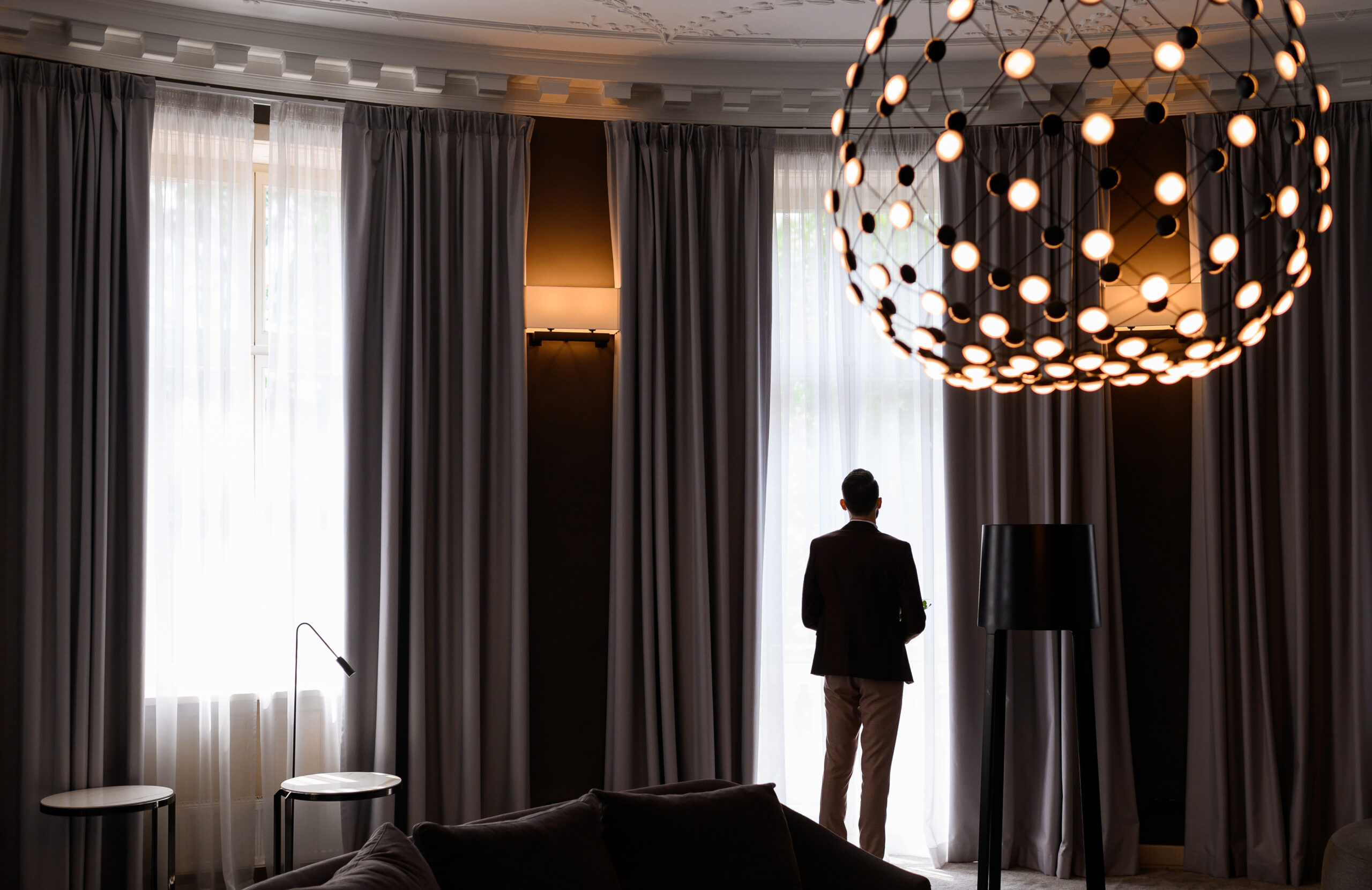Why Tailored Window Treatments Make a Difference
Function meets aesthetics in interior design
Drapery is more than fabric on a rod. In well-considered spaces, it balances form with purpose. Whether softening the edges of a room or framing a striking view, custom drapery plays an active role in shaping a room’s feel. Unlike off-the-shelf options, tailored drapes respond to the room’s lighting, scale, and proportions with accuracy. This ensures that every fold, pleat, and panel serves both visual and functional intent.
The right drapery can reduce glare, insulate against heat loss, or shield private spaces without compromising natural light. When paired with the right fabric and hardware, it becomes part of the architecture—not just a decorative layer. It’s this kind of deliberate pairing of form and function that creates a polished, high-end atmosphere.
Made-to-measure versus ready-made drapery
The fit of drapery matters. Ready-made options rarely align perfectly with non-standard window sizes or unique design requirements. They often hang awkwardly or require compromise. Made-to-measure solutions eliminate these issues entirely. They’re tailored to suit exact window dimensions and drop lengths, creating a clean, intentional look that’s hard to replicate with mass-market alternatives.
A custom drapery workroom near me understands how to bring a designer’s vision to life without the guesswork. This means a more cohesive design, seamless alignment with other furnishings, and less time spent correcting imperfections. When each element is made to suit, the overall effect feels calm, structured, and refined.
Design continuity and visual impact
Cohesion within a room relies on repetition and rhythm. Custom drapery allows for consistency across multiple rooms or within open-plan layouts. Fabric choices can be matched to upholstery, trims to cushions, and pleats to architectural features. This continuity contributes to a luxurious atmosphere that feels deliberate and unified.
Designers often use drapery to lead the eye across the space. Floor-to-ceiling panels can heighten a room visually, while patterned or textured drapes can add character without relying on loud statement pieces. When the fabrication reflects the same attention to detail as the surrounding space, it reinforces the atmosphere of thoughtful design.
Fabric Choices and Their Role in Luxury
Textural depth and light filtration
Texture defines much of how a space feels. The tactile quality of linen, the smooth finish of silk, or the weighty presence of wool all convey different moods. In luxury interiors, fabric is chosen not only for looks but for how it interacts with light and touch. Drapery that shifts tone as daylight changes adds a subtle drama to the room, while sheer layers can soften shadows and offer depth.
Light filtration is another critical consideration. Sheers diffuse daylight without blocking it, while thicker fabrics add richness and insulation. Layering these options creates a dynamic environment that responds to the time of day and season.
Popular high-end fabric types
Silk remains a top choice for formal spaces, offering natural sheen and fluid drape. However, velvet, linen blends, and cotton sateen are just as popular in contemporary settings. Each comes with distinct visual qualities—velvet absorbs light for a plush look, while linen offers a relaxed texture that suits modern and transitional interiors.
Performance fabrics, too, are seeing wider use in high-end settings. They combine durability with aesthetic appeal, ensuring that even sun-exposed windows or high-traffic areas maintain their finish over time. The right workroom will help assess the environment, suggesting materials that balance performance with elegance.
Colour, pattern, and mood setting
Colour in drapery anchors a room. Rich hues like emerald, navy, or oxblood create drama, while soft neutrals offer a restrained backdrop for bolder decor. Pattern can be used sparingly, such as in banded trims or subtle tone-on-tone prints, to avoid visual overload. In many luxury interiors, less is often more—restraint communicates confidence.
Drapery serves as both a visual anchor and a frame for the room’s natural light. In the hands of a skilled workroom, this frame becomes a defining feature. Designers looking for custom drapery in Denver often factor in seasonal light changes and elevation, ensuring colour and weight choices remain functional and beautiful all year.
The Art of Pleating and Detailing
Pleat styles that elevate a room
Pleats might seem like a small detail, but they shape how fabric falls and how a window feels within a room. The classic pinch pleat suits traditional interiors, offering symmetry and fullness. Inverted pleats create a tailored look with sharp folds that complement modern designs. Goblet pleats, with their structured elegance, add a formal touch perfect for grand rooms.
Each pleat style brings its own personality. The choice depends not only on the visual direction of the space but also on how the fabric behaves. A well-constructed pleat ensures that even heavy materials hang evenly and retain their structure over time.
The craftsmanship behind every fold
Precision is everything in drapery work. Achieving symmetry in folds, ensuring accurate hem lengths, and aligning patterns all require a practised hand. It’s here that a custom drapery workroom near me becomes indispensable. They work from exact measurements and deliver tailored results that mass production simply can’t match.
Even subtle choices, like using hand-stitched hems or weighted corners, influence how the drapery behaves. These small additions maintain the drape’s line and create a polished look that doesn’t shift with every breeze. The overall effect is one of care and permanence—attributes central to any luxurious space.
Trims, tapes, and customised finishes
Decorative trims are often the final step in making custom drapery feel truly bespoke. Greek key patterns, contrast banding, or hand-applied braids draw attention to clean lines or architectural details. Tapes and borders in contrasting or complementary colours help tie the drapery into the broader palette of the room.
Custom finishes also include options like puddling the fabric for added drama or incorporating blackout linings to balance luxury with practicality. These are decisions best made alongside a skilled fabricator, ensuring the results are both attractive and lasting.
Layering Techniques for Depth and Function
Combining drapes with sheers or blackout linings
Layering brings flexibility. Sheers allow filtered light and daytime privacy, while heavier drapes provide darkness and insulation. Used together, they form a dynamic system that adapts to time and mood. The softness of sheers behind structured panels adds both comfort and depth.
Blackout linings are often chosen for bedrooms, nurseries, or media rooms, but they also add weight and richness to the drape. This extra layer helps the fabric hang better and ensures a uniform appearance from outside the home. For clients who want both aesthetics and function, this approach offers the best of both.
Valances, cornices, and the finishing touch
Top treatments frame the window and cover hardware, giving the installation a clean, finished look. Valances in coordinating or contrasting fabrics can soften the space, while upholstered cornices provide structure. These additions add height and emphasis, drawing the eye upward and making ceilings feel taller.
A skilled installer will ensure these pieces sit perfectly above the drapery, adding impact without bulk. In luxury interiors, every detail counts—including what sits above the window frame.
Tailoring light control and privacy
In shared spaces or homes with close neighbours, privacy without complete darkness is a priority. Layered treatments provide control over how much is revealed at different times of day. Motorised options can add convenience, especially for larger installations or hard-to-reach windows.
Designers working with custom drapery in Denver often prioritise flexibility. The city’s bright sunlight and variable seasons require options that adapt without compromising on appearance. Layering gives the control needed for comfort, privacy, and visual impact all year round.
Working with a Custom Drapery Workroom Near Me
Benefits of local expertise and collaboration
Choosing a local workroom does more than simplify logistics—it creates opportunities for true collaboration. Meeting face-to-face fosters clearer communication, quicker decision-making, and stronger trust. A local team understands regional styles and preferences, offering informed suggestions that suit both the space and its environment.
When working with designers or trade professionals, a nearby workroom becomes part of the extended design team. Their ability to consult directly, adjust in real-time, and offer sample reviews speeds up the process without compromising quality. With hands-on access, problems are resolved before they escalate, and ideas come to life faster.
Faster turnaround and communication
Timelines matter, especially when coordinating with builders, upholsterers, or other trades. A local workroom shortens lead times on approvals, fittings, and final installs. Rather than shipping materials or relying on remote updates, the process becomes streamlined and responsive.
Clear communication is just as critical as speed. Being in the same region reduces lag in replies, offers flexibility for urgent revisions, and gives clients more control over their schedule. A custom drapery workroom near me is easier to reach, easier to work with, and more invested in delivering exceptional outcomes.
Ensuring precision from start to finish
Luxury is measured in detail. Slight discrepancies in measurement or misalignment in pleating can disrupt the overall look. A trusted local workroom will oversee every step, from site measurement to final hanging, with accuracy and consistency.
Their knowledge of standard practices, combined with the flexibility to adapt to unusual spaces, ensures that drapery always fits as it should. Corners are mitred properly, linings are even, and seams are near invisible. It’s this level of quality control that sets custom work apart.
Why Custom Drapery in Denver Stands Out
Regional styles and preferences
Every region has its own design identity. In Denver, preferences often balance natural materials with clean lines, blending comfort with sophistication. Custom drapery in Denver reflects this by incorporating linen, wool, and neutral palettes that complement Colorado’s landscapes and light.
Designers frequently work to enhance mountain views or soften the industrial edge of newer builds. Local fabricators understand how to support these goals, recommending pleats, trims, and fabrics that respect the setting without overpowering it.
Climate and light considerations
Denver’s high altitude and 300+ days of sun affect how fabric behaves. UV exposure can cause fading, and dry air impacts how materials hang. A workroom familiar with these conditions will recommend linings and fabric blends that resist damage and keep their shape.
Rooms facing west need different solutions than those with northern light. Drapery that looks luxurious also needs to perform under real conditions. The right local partner knows what holds up, what stretches, and what reacts to daily temperature changes—vital knowledge for longevity.
Partnering with professionals who understand local needs
Custom drapery isn’t just about aesthetics. It’s about solving real challenges in a beautiful way. In Denver, that might mean thermal insulation, privacy in close-knit neighbourhoods, or seamless integration with architectural features like exposed beams or large picture windows.
Workrooms that operate in the area have seen these challenges before and know how to work around them. Their input becomes as valuable as that of the designer, ensuring the result isn’t just attractive but practical too.
Final Considerations When Planning a Luxurious Look
Measuring, fabrication, and installation timelines
Timelines can vary significantly depending on fabric availability, workroom schedule, and project complexity. Precision begins with measuring. Professionals assess each opening, consider floor variations, and determine mounting positions to ensure consistent results. From there, fabrication may take several weeks, particularly for fully lined panels or detailed embellishments.
Installation is the last but most important step. Even perfectly constructed drapes can disappoint if hung incorrectly. A team experienced in luxury treatments handles every detail—ensuring symmetry, smoothing pleats, and adjusting for final fit. The workroom often coordinates directly with the installer to guarantee alignment between fabrication and execution.
Clients engaging a custom drapery workroom near me often benefit from tighter coordination across these stages. The result is a process that feels less fragmented and more in sync with other parts of the project.
Budgeting for quality and craftsmanship
Luxury drapery is a long-term investment. High-end fabric, detailed finishing, and custom installation do carry a higher initial cost. However, these elements also mean better durability, reduced maintenance, and timeless appeal. Over time, the added value in comfort, energy savings, and visual harmony justifies the initial expense.
A quality workroom will walk through options that align with the client’s budget without compromising the result. That could mean switching to performance fabrics for sun-facing rooms or adjusting pleat styles to save on yardage without affecting fullness. Strategic choices like these make custom drapery accessible while maintaining its luxurious finish.
Long-term value and durability
Custom drapery made with care does not age like mass-produced alternatives. Seams stay secure, linings retain their form, and hardware holds up to years of use. When minor repairs or adjustments are needed, local workrooms can often address them without starting from scratch.
In climates like Denver’s, resilience matters. Choosing custom drapery in Denver ensures the material, construction, and installation meet regional demands. The outcome is not just a beautiful window treatment—it’s one that continues to function and impress for years to come.




